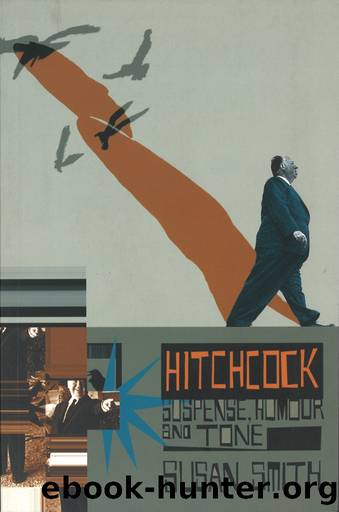Hitchcock by Susan Smith;

Author:Susan Smith;
Language: eng
Format: epub
Publisher: Bloomsbury UK
Published: 2008-06-15T00:00:00+00:00
Chapter 4
Mise en scène
Setting the scene
In addition to attending to the kinds of narrative strategies relating to suspense and humour that were covered in Chapters 2 and 3, this book attaches central importance to the role played by mise en scène in embodying certain ways of thinking and feeling about a filmâs fictional world. As the later analysis of The Paradine Case will seek to demonstrate, the overall spatial system of a film â how it organises, segments and presents the various settings of its narrative world â is crucial in orientating the viewerâs attitudinal (not just literal) perspective. At the other extreme, the specific contents or fabric of a film â how it selects and uses the various aspects of its decor â is, as the section on objects aims to show, equally important in offering distinctive ways of relating to the characters and their fictional universe. These are aspects of Hitchcockâs mise en scène that have often been overlooked in favour of the point-of-view shot, the emphasis upon which has tended to reflect and shape critical perceptions of Hitchcockâs cinema as a primarily subjective one. This chapter will take a fresh look at this much discussed aspect of camerawork in Hitchcockâs films, on the one hand reassessing its often perceived role as a device for effecting audience identification with the characters while on the other hand considering its function as a determinant of suspense and other aspects of tone. In conjunction with this analysis of setting, decor and camerawork, the study will look at how the tonal properties of Hitchcockâs films can often be explained in terms of a âputting into the sceneâ of certain rhetorically charged elements. While this is something that will be traced (in a range of inflected ways) across all of the main areas covered by this chapter, it culminates in a consideration of Hitchcockâs tendency to inscribe two elements into the scene that may be thought of, more typically, as belonging outside of the narrative diegesis â namely, the figure of the director himself (through the device of the cameo apppearance) and various forms of music (with particular emphasis being placed upon the propensity for such music to inherit, dramatize and intensify certain tonal characteristics of the soundtrack score and, indeed, of the Hitchcock thriller more generally).
Before looking at one particular filmâs use of setting I would like to start by examining Hitchcockâs penchant for employing parties as a staging device for drawing out the tonal characteristics of a scene. We have already encountered the most sustained instance of this in Chapter 3, as Ropeâs entire narrative is based upon the staging of a macabre post-murder party in Brandon and Phillipâs apartment. As I mentioned then, this is symptomatic of a much more prevalent tendency in Hitchcockâs films. Notorious, for example, contains no less than three parties, each of which is positioned at key stages of the narrative. The first one takes place in Florida at Aliciaâs house right after her fatherâs trial
Download
This site does not store any files on its server. We only index and link to content provided by other sites. Please contact the content providers to delete copyright contents if any and email us, we'll remove relevant links or contents immediately.
Still Foolin’ ’Em by Billy Crystal(36065)
Spell It Out by David Crystal(35858)
The Great Music City by Andrea Baker(30809)
Professional Troublemaker by Luvvie Ajayi Jones(29427)
Trainspotting by Irvine Welsh(21051)
Call Me by Your Name by André Aciman(19941)
We're Going to Need More Wine by Gabrielle Union(18649)
The Secret History by Donna Tartt(18236)
Cat's cradle by Kurt Vonnegut(14785)
Ready Player One by Cline Ernest(14036)
Molly's Game by Molly Bloom(13896)
Bombshells: Glamour Girls of a Lifetime by Sullivan Steve(13706)
The Goal (Off-Campus #4) by Elle Kennedy(13213)
Leonardo da Vinci by Walter Isaacson(12821)
The Social Justice Warrior Handbook by Lisa De Pasquale(11964)
4 3 2 1: A Novel by Paul Auster(11823)
The Break by Marian Keyes(9091)
Crazy Rich Asians by Kevin Kwan(8903)
Adultolescence by Gabbie Hanna(8601)
